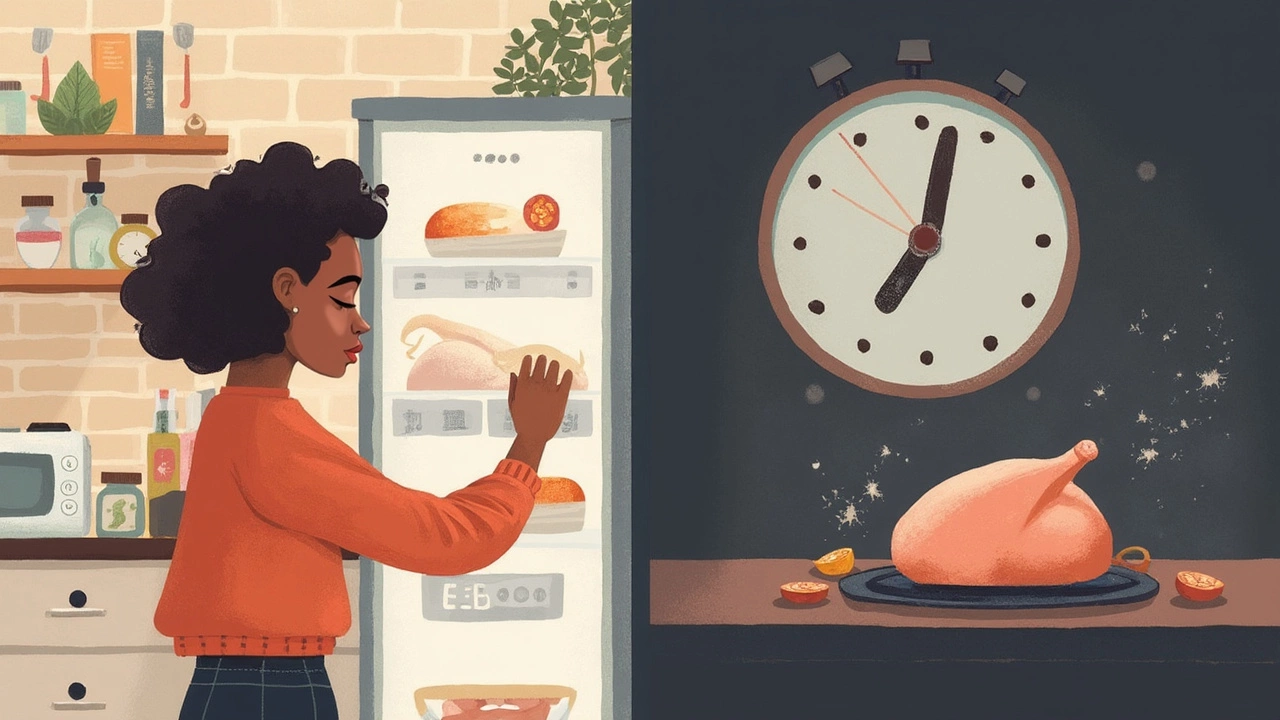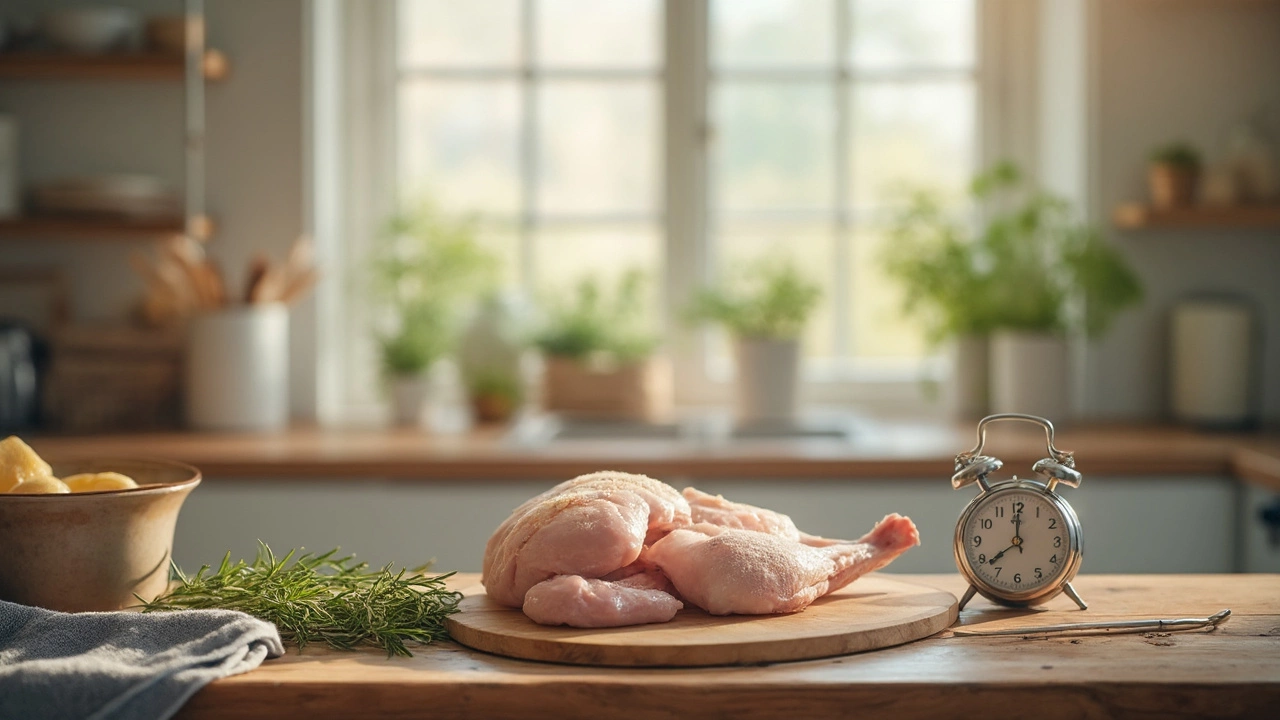Chicken straight from the fridge can be a pain. Ever tried to sear cold chicken breast and ended up with a tough outside and a raw middle? Yeah, that's because cold meat cooks unevenly. But here's the thing—leave raw chicken out too long, and you risk bad bacteria showing up. So, how long can you really let chicken sit at room temperature before cooking it?
If we're talking quick prep, most experts agree: 15 to 30 minutes is the safe window. That’s just enough time to knock the chill off and get more even cooking, but not so long that things get sketchy. This is a game changer for juicy, well-cooked chicken. Just set it on a plate, cover it lightly, and let it sit while you prep your sides.
- The Science of Room Temperature Chicken
- Safe Time Limits: What Experts Say
- Easy Tricks to Bring Chicken Up to Temp
- What Happens If You Go Over the Limit?
- Flavor Boost: Does Resting Really Help?
- Myths and Fast Facts
The Science of Room Temperature Chicken
Cold chicken straight from the fridge is way denser than you think. When you put it in a hot pan or oven, the outside starts cooking fast, but the inside stays chilly. That’s why people end up with dry edges or a pink center—not exactly ideal if you want juicy, fully cooked chicken.
Why even bother letting chicken warm up a bit? When meat sits at room temperature, the protein fibers relax. This helps it cook more evenly and cuts down cooking time. You’re less likely to overcook the outside while waiting for the inside to catch up. Even just 20 minutes can make a big difference between chewy and tender results.
Now, here’s the food safety side. Bacteria like Salmonella and Campylobacter love temperatures between 40°F and 140°F. This is what food pros call the “danger zone.” Chicken left in that range for too long can start to grow these bugs, and no one wants a recipe for food poisoning. Want numbers? Check this out:
| Temperature Zone | Time Limit |
|---|---|
| Below 40°F (Fridge) | Safe for 1-2 days |
| 40°F–140°F (Danger Zone) | Not safe after 2 hours (1 hour if over 90°F room temp) |
| Above 165°F (Cooked) | Safe to eat |
What does this mean for your chicken game? Take it out just long enough to lose that fridge chill (think 15-30 minutes max), but don’t get distracted and leave it sitting all afternoon. A timer on your phone never hurts. Safe chicken is tasty chicken, and that extra planning pays off at dinner.
Safe Time Limits: What Experts Say
So, how long can chicken actually hang out on your counter before you’re taking a gamble? Here’s what the pros agree on: raw chicken shouldn’t sit out at room temperature for more than two hours. And if it’s a hot day—think above 90°F (32°C)—that window shrinks to just one hour. It’s not just being picky. At this point, bacteria like Salmonella and Campylobacter can multiply like crazy.
Here’s a quick comparison that sums up the recommendations from the USDA and top food safety experts:
| Temperature | Max Safe Time |
|---|---|
| Below 90°F (32°C) | Up to 2 hours |
| Above 90°F (32°C) | Up to 1 hour |
But for best results in your chicken recipes, you don’t even need the full two hours. Most cooks only let chicken rest 15–30 minutes on the counter right before cooking. This gives you the even temperatures you want for juicy chicken, and also keeps things safe.
To make sure you’re playing it safe, follow these quick tips:
- Set a timer so you don’t lose track—seriously, it’s easy to forget.
- If you get interrupted (phone call, kids, whatever), just pop the chicken back in the fridge until you’re ready.
- Never let chicken sit out in direct sunlight or a hot kitchen.
Bottom line: it’s a balance between better flavor and safety. That quick 15–30 minute rest goes a long way, but don’t push your luck past the two-hour mark.
Easy Tricks to Bring Chicken Up to Temp
Getting chicken to the right temp before it hits the pan is easier than most folks think. You don’t need any special gear, just a bit of timing and common sense. Here’s how the pros and home cooks keep things both safe and tasty:
- Set a Timer: Take your chicken out of the fridge about 20–30 minutes before cooking. This short room-temp rest means it cooks more evenly. Any longer and you’re tempting trouble, bacteria-wise.
- Keep It Covered: Loosely cover the chicken with foil or plastic wrap. This keeps out dust, pets, and accidents—no one wants surprise fuzz in their dinner.
- Use a Plate: Always sit the chicken on a plate or tray, not straight on the counter. This keeps juices contained and your prep area clean.
- Flip for Thicker Cuts: If you’re prepping breasts or thighs that are extra thick, flip them halfway through the rest. This helps warm them evenly.
- Don’t Marinate on the Counter: Marinating adds flavor, but always do it in the fridge—not on the counter. Save the temp boost for right before you cook.
How much warmer does your chicken really get at room temp? Check out this quick chart for a standard 6-ounce chicken breast resting at 70°F:
| Time Out of Fridge | Internal Temp |
|---|---|
| 0 minutes | 40°F (fridge temp) |
| 10 minutes | 45°F |
| 20 minutes | 50°F |
| 30 minutes | 55°F |
| 40 minutes | Near 60°F |
That sweet spot—15 to 30 minutes—gets the chill off, especially for average-size pieces. If you’re working with a whole chicken, it can take closer to an hour, but stick to the 30-minute rule for safety. Want the juiciest results? Resting chicken before cooking, even for a little while, lets muscle fibers relax and juices spread. That makes every bite better. And remember, chicken that starts warmer cooks more evenly and tastes way better than cold, straight-from-the-fridge meat.

What Happens If You Go Over the Limit?
Leaving chicken out at room temperature for too long isn't just a bad habit—it's asking for trouble. Once chicken sits out for over 2 hours (or just 1 hour if your kitchen's over 90°F), bacteria like Salmonella and Campylobacter can multiply fast. These aren't just science-class names; they're the main culprits behind food poisoning that sends thousands to the ER every year.
You can't tell if chicken's gone bad just by looking or smelling. Harmful bacteria don't always change the color or odor. So, you could be cooking up a dish that looks perfect but packs a dangerous punch. Here’s what can happen if you ignore the clock:
- Nausea, vomiting, and diarrhea—classic symptoms that knock you down for a day or two.
- Severe cases can lead to dehydration and, yes, sometimes hospital visits—especially for kids, pregnant women, and older adults.
- Cooking won’t always save the day. Some bacteria release toxins that stick around even after you cook the chicken.
If you’re thinking, “Hey, nobody’s ever gotten sick at my cookouts,” here’s a little reality check. According to the CDC, over a million people in the U.S. get sick from eating contaminated poultry each year.
| Max Safe Time at Room Temperature | Risk Level After Limit | What Can Happen |
|---|---|---|
| Up to 30 minutes | Safe | Juicy, evenly cooked chicken |
| 1-2 hours | Borderline | Bacteria start building up—still looks fine |
| Over 2 hours | Unsafe | High risk of foodborne illness, invisible spoilage |
If you lose track of time, just toss it. Saving a few bucks isn’t worth a night hugging the toilet. Stick to the safe window—your stomach will thank you.
Flavor Boost: Does Resting Really Help?
Resting chicken at room temperature actually does more than just make cooking easier. When you let your chicken sit out for 15 to 30 minutes before it hits the pan, you’re setting yourself up for juicier and more evenly-cooked meat. Cooks at big restaurant chains and even top food scientists say that chicken proteins relax as they warm up, which lets heat travel through the meat better. That means you’re not stuck with dry edges and a raw inside.
Some folks ask if this short room-temp rest really changes the chicken flavor. The answer? It’s not so much about flavor, but texture. Letting meat warm up prevents that tough, rubbery bite from pan-seared or grilled chicken straight from the fridge. Juices stay put, and you won’t watch them all run out when you slice it up.
If you’re marinating, this is also the sweet spot where your flavors unlock. The surface isn’t icy-cold, so spices and acid in your marinade actually start doing their job. Use this 15 to 30-minute window especially if you’re grilling or pan-frying. Just remember, don’t go over 30 minutes or you’re pushing it with food safety.
- If you’ve got thick chicken breasts, place them loosely covered so air can circulate, but germs can’t drop in.
- Set a timer—don’t just eyeball it. Getting distracted is easy.
- If the kitchen is hot (over 80°F), shave the time even shorter. Bacteria multiply fast when it’s warm out.
So, does the resting trick help? For softer bites and fewer dry spots, it definitely works. It’s one of those small steps that’s easy to skip, but once you taste the difference, you’ll add it to every cookout or family dinner. No need for fancy gear or extra gadgets—just a plate, a bit of patience, and you get a better meal.
Myths and Fast Facts
There’s a ton of weird advice out there about how long to leave chicken out, and a lot of it is just plain wrong. If you’ve ever heard someone say, “Raw chicken is fine at room temperature for hours,” please don’t listen. That’s not just risky—it’s a quick way to get sick. Let’s clear up a few big myths and nail down the facts.
- Myth #1: Leaving chicken out for a couple of hours is perfectly safe. Nope. Bacteria like Salmonella and Campylobacter love lukewarm chicken. Food safety authorities keep it simple—don’t let raw chicken sit out longer than an hour if it’s hot in your kitchen, or two hours max at normal room temperature (around 68–72°F or 20–22°C).
- Myth #2: Chicken tastes better if you let it sit out for a long time before cooking. Sure, taking the chill off helps, but you only need 15–30 minutes. More than that, you’re taking risks, not gaining flavor.
- Myth #3: You can ‘just cook off’ any bacteria. Heating chicken kills bacteria—but only if bacteria haven’t multiplied a ton on the meat. Letting chicken hang out too long means nasty toxins could stick around, even after cooking.
Now for some facts you can trust:
- Keep chicken in the fridge until you’re almost ready to cook. The less time it spends at room temp, the better.
- If you forget and leave chicken out more than two hours (or just one hour on a hot day), toss it. Trust me on this—saving a few bucks isn’t worth food poisoning.
- Always use a meat thermometer. The safe finish line is 165°F (74°C) for all chicken cuts.
- Chicken recipes often turn out juicier when you let the meat lose its chill, but don’t skimp on safety.
No fancy hacks or shortcuts here—just the real kitchen habits that keep you healthy and your chicken tasty.

